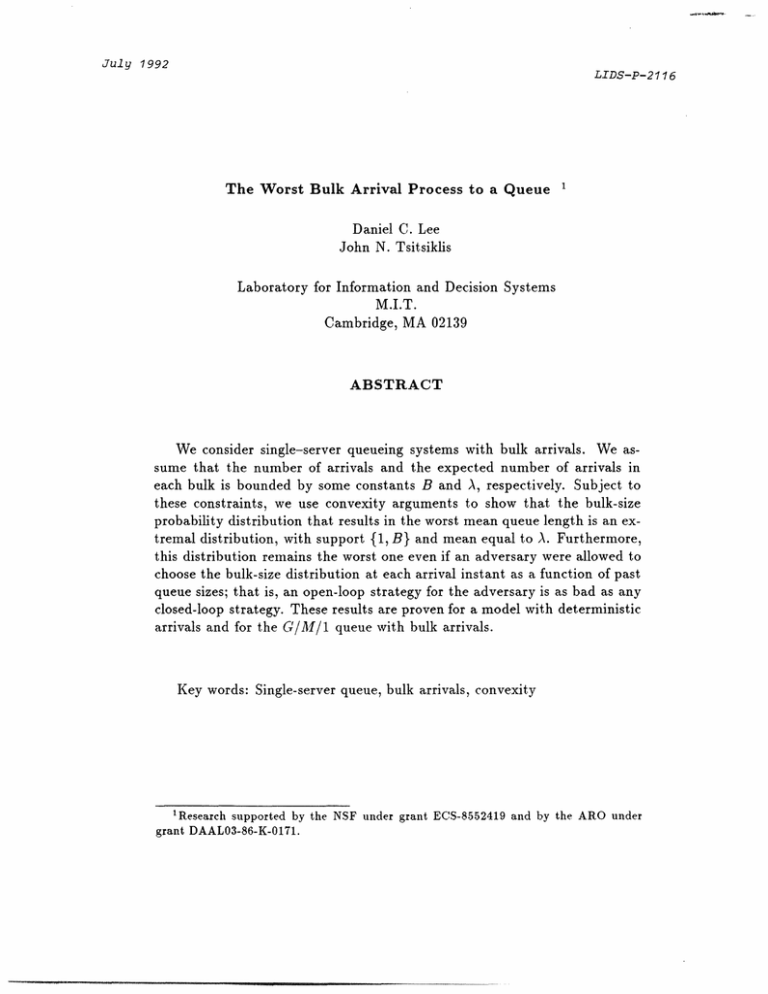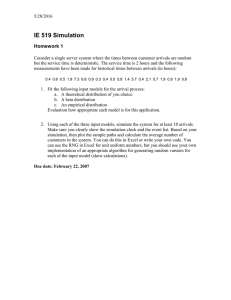The Worst Bulk Arrival Process ... Daniel C. Lee John N. Tsitsiklis
advertisement

July 1992
LIDS-P-2116
The Worst Bulk Arrival Process to a Queue 1
Daniel C. Lee
John N. Tsitsiklis
Laboratory for Information and Decision Systems
M.I.T.
Cambridge, MA 02139
ABSTRACT
We consider single-server queueing systems with bulk arrivals. We assume that the number of arrivals and the expected number of arrivals in
each bulk is bounded by some constants B and A, respectively. Subject to
these constraints, we use convexity arguments to show that the bulk-size
probability distribution that results in the worst mean queue length is an extremal distribution, with support {1, B} and mean equal to A. Furthermore,
this distribution remains the worst one even if an adversary were allowed to
choose the bulk-size distribution at each arrival instant as a function of past
queue sizes; that is, an open-loop strategy for the adversary is as bad as any
closed-loop strategy. These results are proven for a model with deterministic
arrivals and for the G/lM/1 queue with bulk arrivals.
Key words: Single-server queue, bulk arrivals, convexity
1
Research supported by the NSF under grant ECS-8552419 and by the ARO under
grant DAAL03-86-K-0171.
1
Introduction
In this paper, we consider single-server queueing systems with bulk arrivals,
described in terms of three stochastic processes, assumed to be statistically
independent of each other: a) an arrival process that specifies the times at
which customers arrive; b) a bulk-size process that describes the number
of arrivals at each arrival time; c) a service process that determines the
service completion times of the customers in queue. We assume that the
statistics of the arrival and the service processes are given. Regarding the
bulk-size process, we assume that the bulk-sizes at different arrival times are
statistically independent and that the bulk size at the n-th arrival time is a
random variable U, described by a probability mass function f,. Subject to
the constraints E[U,] < A and U E {1,... , B}, we are interested in finding
a sequence {f,}=l of bulk-size distributions that leads to the worst possible
values for certain natural performance measures such as the expected number
of customers waiting in queue. Let F be the set of all probability mass
functions satisfying the above two constraints, and let Yx be the subset of F
in which the constraint E[Ul] < A is satisfied with equality, Throughout the
paper, we assume that A < B so that Fx) and F are nonempty. Let f* f F
be the "extremal" distribution defined by
f*(i)=
{
B
ifi1=
0,
if 1 < i < B,
-1if i = B.
B-i'
Our results establish that for a wide class of systems and performance measures, the worst case sequence of bulk-size distributions is the sequence
7r* = (f*, f*, ... ). The set of systems to be considered include G/M/1 queues
with bulk arrivals. We conjecture that a similar result is also valid for G/G/1
queues with bulk arrivals.
It will be seen that, in fact, our results hold in an even stronger sense. Let
us introduce an adversary who at any arrival time, is allowed to choose the
distribution of the current bulk-size based on a fair amount of information on
the realization of the arrival and service processes. We will show that even
under such circumstances, the sequence 7r* remains the worst-case choice of
bulk-size distributions. In other words, it makes no difference if we allow
the adversary to use "closed-loop" strategies. Furthermore, statistical dependence between the bulk-sizes at different arrival times cannot worsen the
value of the performance measures under consideration.
It is fair to view f* as the "most bursty" element of F. In that respect,
our results establish that out of all bulk-size processes with given mean and
support, the most bursty one leads to the worst queueing delay. This result
can be viewed as the opposite extreme of the fact that, for a fixed arrival
intensity, and for a broad class of queueing systems, a deterministic arrival
process minimizes the average waiting time [4, 3]. (A deterministic arrival
process can be viewed as the "least bursty" arrival process.)
As a final remark, we note that the problem facing the adversary, and the
resulting optimal policy, have similarities with some previously studied gambling problems [1, 2]. It is also related to the results of [5] where it is shown
that the distribution f* corresponds to the worst possible average behavior
of a class of randomized algorithms. Nevertheless, the problems in the above
references do not seem to have queueing-theoretic interpretations.
2
Preliminaries
All of our results rely on the following simple property of the distribution
f*. It can be proved using stochastic dominance results (Example 1.9(b)(ii)
in p. 25 of [6]), but a proof is provided to keep the paper self-contained.
Lemma 1 Let U be a random variable with probability mass function f GE
and let g:
3-?R
be convex. Then, the value of E[g(U)] = E-ul f(u)g(u) is
maximized over all f E Fx if f = f*. Furthermore,if g is also nonincreasing,
then f* maximizes E[g(U)] over the set f as well.
-R
Proof
Consider some f E SFx such that f(v) = 6 > 0 for some v satisfying 1 <
v < B. We construct another probability mass function f GCFx by letting
f(v) = O, f(B) = f(B) + (v - 1)6/(B - 1), f(1) = f(1) + (B - v)6/(B - 1),
2
and f(u) = f(u) if u ¢
1,v, B}. It is easily seen that f E Yx.
B
A= E
u=l
f(u)g(u) -
Let
B
E f(u)g(u)
iu=l
Then,
1 6[ 9(1) -g(v)
B - 1[ g(B) - g(v) ] +
v-
-v
B
E [g(i)-g(i - 1)]= B-l6
B-1 i=v+l
B-
> (B-v)
]
I 6[ g(v + l) - g(v)
[g(i)-g(i - 1)
i=2
(v - 1)(
v 8S
1 - g(v) B
= 0
The inequality above follows from the convexity of g. By repeating this process up to B - 2 times, we end up with a probability mass function which
is zero outside {1, B} and which belongs to F'x. Such a probability mass
function can only be equal to f*. Furthermore, throughout this process, the
value of the objective function cannot decrease, and this shows that f* maximizes the objective function over the set F)x. Let us now assume that g is
nondecreasing. Then, it is clear that by increasing the mean of U, we can
increase E[g(U)], and this implies that the maximum of E[g(Ul)] over Fx is
the same as the maximum over F. Q.E.D.
Lemma 2 If the functions f: 'RER R and g : Z +
nondecreasing, the composite function, f o g : Z +
R are convex and f is
is convex.
Proof
f(g(Ax + (I - A)y))
<
f(Ag(x) + (1 - A)g(y))
< Af(g(x)) + (1 - A)f(g(y))
The first inequality holds because g is convex, and f is nondecreasing. The
second inequality holds because f is convex. Q.E.D.
3
3
A simple discrete-time model with deterministic interarrival times
In this section, we consider a simple discrete-time queueing system. The arrival process is deterministic with arrivals occurring at each integer time. The
service process is specified in terms of a sequence {Q,} of random variables
as follows: the number of customers served during the time interval [n, n + 1)
is equal to Q, unless we run out of customers in the queue. More precisely,
let X(t) be the number of customers in the queue at time t, assumed to be
a right-continuous process. Then, X(t) changes only at integer times and
evolves according to the equation
X(n + 1) = [X(n) - Q,] + [U.+
(1)
where we have used the notation [a]+ = max{a, 0}.
Theorem 1 The sequence of bulk-size distributions7r* maximizes E[g(X(n))]
for every nonnegative integer n and for every convex and nondecreasingfunction g: R - .
Proof
Fix some n and let m < n. We will show that the worst-case bulk-size
distribution f, at time m is equal to f*. Let us fix a sample path of the
service process {Qn} and let us also condition on the values of {UUk I k # m).
Using Lemma 2, an easy inductive argument based on Eq. (1) shows that
X(n) is a convex nondecreasing function of Urn. Using Lemma 2, g(X(n))
is also a convex nondecreasing function of Urn. Then, Lemma 1 implies that
E[g(X(n)) I {Q,}, {,Uk, k
#
m}]
(2)
is maximized by letting f,
= f*. It follows that E[g(X(n))] is also maximized by letting fm = f*. Since this argument is valid for every m, the result
is proved. Q.E.D.
The fact that f, = f* maximizes expression (2) for each realization of {Qn}
and {Uk,k # m} generalizes the result of Theorem 1 further. Even if an
4
adversary were given knowledge of the sample path of the service process
{Q,}, and were allowed to choose the bulk-size distributions based on such
information, the sequence xr* would be still chosen for the purpose of maximizing E[g(X(n))] for the following reason. Since f m = f' maximizes the
expression (2) for each sample path of {Q,} and {Uk, k #d m}, f m = f*
maximizes E[g(X(n)) I {Q,)] without regard to the choice of {fk, k # m}.
As a result, 7r* maximizes E[g(X(n)) I {Q,}] for each sample path of {Q,}.
Therefore, 7r* maximizes E[g(X(n))].
Moreover, consider a case where an adversary is given knowledge of the realization of {Uk, k < m} at each decision making time m as well as the sample
path of the service process {Qn}, and is allowed to choose the bulk-size distributions based on such information. In this case, an adversary is allowed
to exercise a closed-loop strategy, where a closed-loop strategy is defined as
a set of mappings
m :{ {Qn} } x { {Uk, k < m}
}
,
integer m
Even in this case, an open-loop strategy that uses the sequence ir* maximizes E[g(X(n))] for the following reason. At each time m, f m = f*
maximizes expression (2) for each realization of {Q,}, {Uk, k < m}, and
{Uk, k > m}. Therefore, without regard to mappings {tLk,k # m}, fm = f*
maximizes E[g(X(n)) I {Qn,, {(k, k < m}] for each realization of fQ,} and
{Uk, k < m}. Therefore, a constant mapping tm({Qn.}, {Uk,k < m})= f*
maximizes E[g(X(n))] for any {ttLk, k
m}. Hence, the open-loop strategy
that uses the sequence 7r* maximizes E[g(X(n))]. Since the open-loop strategy is maximal in the case that the information of {Q,} and {Uk, k < m}
is available to an adversary at each decision making time m, the open-loop
strategy is also maximal for the case that only intermediate amount of information of {Qk, k < m} and {Uk, k < m} is given to an adversary at each
time m. As a side remark, we mention that this result can be alternatively
proven using convexity and backward induction from dynamic programming
equation.
As a corollary of Theorem 1, the sequence 7r* maximizes E[X(n)] for all
n > 0. In particular, it maximizes the infinite-horizon average and the infinite horizon discounted expected number of customers in the system.
5
4
The G/M/1 queue with bulk arrivals
In this section, we extend the results of the previous section to the G/M/1
queue with bulk arrivals. The arrival process is defined here in terms of an
infinite sequence of arrival times. No further assumptions will be needed on
the statistics of this process. Regarding the service process, we assume that
the service time of each customer is exponentially distributed, with mean
one, and that the service times of different customers are independent. As
mentioned in the introduction, we assume that the sequence of service times
is statistically independent of the arrival process. Let X(t) be the queue size
at time t, assumed to be a right-continuous function of time.
Theorem 2 The sequence of bulk!-size distributions-r* maximizes E[g(X(t))]
for every t > 0 and for every convex and nondecreasing function g:
R.
-
Proof
Let A = {Tn I n = 0,1,2,...} denote the arrival process; here Tn are the
arrival times. Let N/ = {N(t) I t > 0} be a right-continuous Poisson counting process with rate 1. The process N(t) models virtual service completion times: at each time that N(t) jumps by 1, service is completed for the
customer currently being served, if any; if no customer is currently served,
nothing happens. Due to the memoryless property of the Poisson process,
this model is equivalent to the standard model of a server with exponentially
distributed service times. Let Xf = X(Tn) be the queue size immediately
after the n-th bulk arrival. We notice that XI, evolves according to
Xn+1
= [Xn - {N(Tn+1 )
-
+
N(T,7 n)}]
+ Un+
(3)
Let us fix some t > 0 and let us fix, by conditioning, a particular sample
path of the process A. Conditioned on A, there exists some n. (depending
on A) such that T, < t < Tn+ 1. Furthermore, X(t) = X - N(t) + N(T,).
6
Let us consider the problem of choosing f m so as to maximize E[g(X(t))
4, {Uk, k #: m}]. This is equivalent to maximizing
E[g([Xn- N(t) + N(Tn)}+) I A, T. < t < T,+1 , {Uk, k
#
m}].
Using Eq. (3), we see that Xn is a convex and nondecreasing function of Urn.
Using Lemma 2 twice, we conclude that g([X. - N(t) + N(Tn)] +) is also a
convex and nondecreasing function of Ur. Lemma 1 then implies that the
maximum is achieved by letting f, = f*. By taking expectations to remove
the conditioning, we conclude that the sequence 7r* maximizes E[g(X(t))] for
all t > 0. Q.E.D.
It is clear from the proof that 7r* would remain the worst-case sequence of
bulk-size distributions even if an adversary were given full knowledge of the
realization of the arrival process A and were allowed to use this information
in deciding the bulk-size distributions. The proof would also remain valid if
we had conditioned on both processes A and A(, and this implies that the
adversary could also be allowed to use full knowledge of both processes. The
sequence 7r* would also remain the worst-case sequence if the adversary were
only given some intermediate amount of information. For example, at any
arrival instant, the adversary might be allowed to use the knowledge of past
arrival times and of the current number of customers in queue; the result
would still be the same.
5
Conclusions
We have derived the worst bulk-size distribution for a variety of single-server
queueing systems. Furthermore, we have shown that this remains the worst
distribution even if an adversary is allowed to make decisions based on a fair
amount of information about the state (or even the future) of the system.
We also conjecture that related results are also valid for G/G/1 queues with
bulk arrivals.
7
References
[1] D.P. Bertsekas, Dynamic Programming: Deterministic and Stochastic
Models (Prentice-Hall, Englewood Cliffs, 1987).
[2] L.E. Dubins and L.J. Savage, How to Gamble If You Must (McGraw
Hill, New York, 1965).
[3] B. Hajek, The proof of a folk theorem on queueing delay with applications to routing in networks, J. Assoc. Comput. Mach. 30 (1983) 834-851.
[4] P.A. Humblet, Determinism minimizes waiting time in queues, MIT
Laboratory for Information and Decision systems Report (1982) LIDSP-1207.
[5] R.M. Karp, Probabilistic recurrence relations. In: Proceedings of the
23rd Annual A CM Symposium on Theory of Computing, (New Orleans,
LA, 1991), pp. 1 90 - 1 9 7 .
[6] D. Stoyan, ComparisonMethods for Queues and other Stochastic Models
(Wiley, New York, 1983).
8






